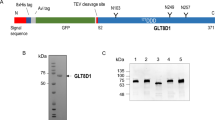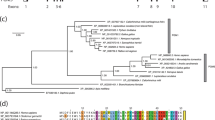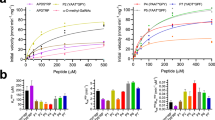Abstract
O-GlcNAc hydrolase (OGA) removes O-linked N-acetylglucosamine (O-GlcNAc) from a myriad of nucleocytoplasmic proteins. Through co-expression and assembly of OGA fragments, we determined the three-dimensional structure of human OGA, revealing an unusual helix-exchanged dimer that lays a structural foundation for an improved understanding of substrate recognition and regulation of OGA. Structures of OGA in complex with a series of inhibitors define a precise blueprint for the design of inhibitors that have clinical value.
This is a preview of subscription content, access via your institution
Access options
Access Nature and 54 other Nature Portfolio journals
Get Nature+, our best-value online-access subscription
$29.99 / 30 days
cancel any time
Subscribe to this journal
Receive 12 print issues and online access
$259.00 per year
only $21.58 per issue
Buy this article
- Purchase on Springer Link
- Instant access to full article PDF
Prices may be subject to local taxes which are calculated during checkout


Similar content being viewed by others
References
Hardivillé, S. & Hart, G.W. Cell Metab. 20, 208–213 (2014).
Groves, J.A., Lee, A., Yildirir, G. & Zachara, N.E. Cell Stress Chaperones 18, 535–558 (2013).
Ferrer, C.M. et al. Mol. Cell 54, 820–831 (2014).
Lagerlöf, O. et al. Science 351, 1293–1296 (2016).
Liu, F. et al. Brain 132, 1820–1832 (2009).
Yuzwa, S.A. et al. Nat. Chem. Biol. 8, 393–399 (2012).
Smith, S.M. et al. Alzheimers Dement. 12, P261 (2016).
Lazarus, M.B., Nam, Y., Jiang, J., Sliz, P. & Walker, S. Nature 469, 564–567 (2011).
Jínek, M. et al. Nat. Struct. Mol. Biol. 11, 1001–1007 (2004).
Gao, Y., Wells, L., Comer, F.I., Parker, G.J. & Hart, G.W. J. Biol. Chem. 276, 9838–9845 (2001).
Cantarel, B.L. et al. Nucleic Acids Res. 37, D233–D238 (2009).
Dennis, R.J. et al. Nat. Struct. Mol. Biol. 13, 365–371 (2006).
Rao, F.V. et al. EMBO J. 25, 1569–1578 (2006).
Macauley, M.S., Whitworth, G.E., Debowski, A.W., Chin, D. & Vocadlo, D.J. J. Biol. Chem. 280, 25313–25322 (2005).
Vocadlo, D.J. Curr. Opin. Chem. Biol. 16, 488–497 (2012).
Butkinaree, C. et al. J. Biol. Chem. 283, 23557–23566 (2008).
Krissinel, E. Nucleic Acids Res. 43, W314–W319 (2015).
Wells, L. et al. J. Biol. Chem. 277, 1755–1761 (2002).
Izumi, T. & Suzuki, K. J. Biol. Chem. 258, 6991–6999 (1983).
Schimpl, M., Schüttelkopf, A.W., Borodkin, V.S. & van Aalten, D.M. Biochem. J. 432, 1–7 (2010).
Cetinbaş, N., Macauley, M.S., Stubbs, K.A., Drapala, R. & Vocadlo, D.J. Biochemistry 45, 3835–3844 (2006).
He, Y., Macauley, M.S., Stubbs, K.A., Vocadlo, D.J. & Davies, G.J. J. Am. Chem. Soc. 132, 1807–1809 (2010).
Cekic, N. et al. Chem. Sci. (Camb.) 7, 3742–3750 (2016).
Shanmugasundaram, B. et al. Chem. Commun. (Camb.) 2006, 4372–4374 (2006).
Bergeron-Brlek, M. et al. Angew. Chem. Int. Edn Engl. 54, 15429–15433 (2015).
Li, M.Z. & Elledge, S.J. Methods Mol. Biol. 852, 51–59 (2012).
Fogg, M.J. & Wilkinson, A.J. Biochem. Soc. Trans. 36, 771–775 (2008).
Kabsch, W. Acta Crystallogr. D Biol. Crystallogr. 66, 125–132 (2010).
Winter, G. J. Appl. Crystallogr. 43, 186–190 (2010).
Evans, P.R. & Murshudov, G.N. Acta Crystallogr. D Biol. Crystallogr. 69, 1204–1214 (2013).
McCoy, A.J. et al. J. Appl. Crystallogr. 40, 658–674 (2007).
Cowtan, K. Acta Crystallogr. D Biol. Crystallogr. 62, 1002–1011 (2006).
Emsley, P., Lohkamp, B., Scott, W.G. & Cowtan, K. Acta Crystallogr. D Biol. Crystallogr. 66, 486–501 (2010).
Murshudov, G.N. et al. Acta Crystallogr. D Biol. Crystallogr. 67, 355–367 (2011).
Adams, P.D. et al. Methods 55, 94–106 (2011).
Winn, M.D. et al. Acta Crystallogr. D Biol. Crystallogr. 67, 235–242 (2011).
Chen, V.B. et al. Acta Crystallogr. D Biol. Crystallogr. 66, 12–21 (2010).
McNicholas, S., Potterton, E., Wilson, K.S. & Noble, M.E. Acta Crystallogr. D Biol. Crystallogr. 67, 386–394 (2011).
Acknowledgements
The authors thank the Diamond Light Source for beamtime (proposals mx-1221, mx-7864, and mx-9948), and the staff of beamlines I02, I03, and I24 for assistance. The authors are grateful to. J.P. Turkenburg and S. Hart for their help in crystal testing and data collection. The authors thank J. Borgia, S. Grist, A. Leech, and L. Haigh for technical support. This research was supported by funding from the Biotechnology and Biological Sciences Research Council (BB/K003836/1) and the Canadian Institutes of Health Research (MOP-123341), Brain Canada, Genome British Columbia, and the Michael Smith Foundation for Health Research. L.I.W. is supported by the Netherlands Organization for Scientific Research (NWO) and the Banting Postdoctoral Fellowships program are also thanked for financial support. R.B. is supported by an MSFHR Career Investigator Award. D.J.V. is supported as a Tier I Canada Research Chair in Chemical Glycobiology. G.J.D. is supported by the Royal Society through a Ken Murray research professorship. S.C. was funded through an Alzheimer's Research UK PhD fellowship.
Author information
Authors and Affiliations
Contributions
C.R. designed truncated constructs and cloned, expressed, crystallized, and solved the structure of the protein. S.C. designed truncated constructs and cloned, expressed, purified, and crystallized protein. W.A.O. cloned, purified, and crystallized protein. G.R.H. designed experiments and cloned and purified protein. L.I.W. performed cell culture and western blot assays. D.T.K. performed the kinetic characterization. V.V. synthesized VV347. R.B. and D.J.V. designed the pyrrolidine inhibitors. G.J.D. designed cloning and structural experiments. D.J.V. designed biochemical and inhibition experiments. C.R., D.J.V., and G.J.D. wrote the manuscript with contributions from all authors.
Corresponding authors
Ethics declarations
Competing interests
D.J.V. is a co-founder of and holds equity in the company Alectos Therapeutics. D.J.V. serves as CSO and Chair of the Scientific Advisory Board of Alectos Therapeutics, of which G.J.D. is a member.
Supplementary information
Supplementary Text and Figures
Supplementary Results, Supplementary Tables 1 and 2 and Supplementary Figures 1–16 (PDF 2317 kb)
Supplementary Note
Supplementary Procedures (PDF 569 kb)
Rights and permissions
About this article
Cite this article
Roth, C., Chan, S., Offen, W. et al. Structural and functional insight into human O-GlcNAcase. Nat Chem Biol 13, 610–612 (2017). https://doi.org/10.1038/nchembio.2358
Received:
Accepted:
Published:
Issue Date:
DOI: https://doi.org/10.1038/nchembio.2358
This article is cited by
-
O-GlcNAc forces an α-synuclein amyloid strain with notably diminished seeding and pathology
Nature Chemical Biology (2024)
-
O-GlcNAcylation determines the translational regulation and phase separation of YTHDF proteins
Nature Cell Biology (2023)
-
Cryo-EM structure of human O-GlcNAcylation enzyme pair OGT-OGA complex
Nature Communications (2023)
-
OGA is associated with deglycosylation of NONO and the KU complex during DNA damage repair
Cell Death & Disease (2021)
-
Target protein deglycosylation in living cells by a nanobody-fused split O-GlcNAcase
Nature Chemical Biology (2021)



